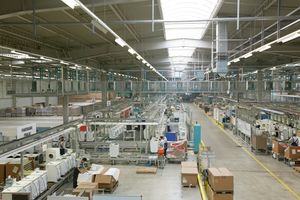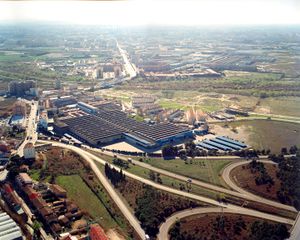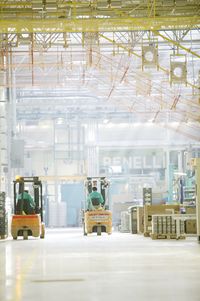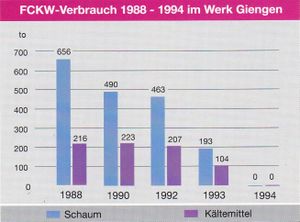BSH Chronology 1984-2002: Sustainability and Internationalization
BSH embarked on a course of international expansion between the years 1984 and 2002, which would change the profile of the company: from a German exporter to a global player with sales companies around the globe and production locations on four of the five continents. Despite the international focus, however, the German site was not neglected. Moreover, topics such as environmental protection and resource conservation were increasingly prioritized by BSH in the 1980s.
The international expansion of BSHG
A new phase commenced for BSHG in 1984[1]: the internationalization of the company. The aim was to systematically develop the German exporter into a global home appliance company with an international technology, marketing and sales network. The reason for this – as explained by BSHG CEO Herbert Wörner – "While BSHG is the fifth largest manufacturer in the world, the company is still far from being a global provider."[2] BSHG worked progressively to achieve this objective over the years that followed.
BSHG essentially expanded in countries where the home appliance market was growing or showed potential for growth. Four internationalization strategies could be identified.
1. The founding of sales and customer service companies in countries where the company was not represented.
2. The establishment of factories in countries where BSHG was not yet present or only had a minor presence.
3. The founding of joint ventures with local partners who had the relevant know-how in the country in question and/or were very familiar with the local market.
4. The majority holding or take-over of regional home appliance manufacturers who could offer a stable or strong market position. BSHG typically knew these companies already through partnerships or through awarding of production orders.
Sales and customer service throughout Europe
The initial strategy centered around the founding of the sales and customer service companies in Europe in the 1980s: 1984 and 1986 in Great Britain[3] and Spain[4], 1985 and 1987 in France[5] and 1987 in Greece[6] and Norway[7].
Development of new factories
Attention focused increasingly on the Eastern European arm of BSHG in the mid-1990s: the Group opened a newly constructed plant for producing washing machines in the Polish city of Lodz in 1994.[8] This meant that BSHG was also represented for the first time in Eastern Europe as a manufacturer of large appliances and was able to exploit its market potential in Poland.[9] The company expanded its position in Eastern Europe in 1998: An assembly plant for cookers was established in Tschernogolowka in Russia, 60 kilometers east of Moscow.[10]
Joint ventures in Asia
The founding of joint ventures with international partners offered BSH opportunities to benefit from the know-how of its partners in the context of the expansion. Entry to the Chinese market was realized in this way – and represented a milestone in the history of BSHG.[11]
The Group founded a joint venture with a leading Chinese washing machine manufacturer in 1994, called the Wuxi Little Swan Group. The Chinese market was attractive for BSHG owing to the large population, growing incomes and central location in Asia.[12] However, there was no unrestricted right of establishment in China for foreign investors.[13] The Group expanded its commitment in China in 1996 when it acquired a cooling appliance factory in Chuzhou.
In 2001, BSH founded a joint venture in the Kabin Buri district of Thailand together with the Japanese electronics corporation Hitachi.[14] BSH had a 60 percent majority holding in the company, which manufactured front-loader washing machines for the Southeast Asian market.[15] Apart from the thriving local economy in Thailand and the central location in Southeast Asia, a key factor in deciding to locate here was the excellent infrastructure of the business district.[16] The joint venture benefited from the technical know-how brought on board by BSH for the production of "Eurowasher" fully automatic front-loader washing machines, while Hitachi was able to offer its own know-how, knowledge of the Thai market as well as existing production facilities. Apart from Thailand, the "Eurowasher" front-loader was also distributed in other countries in Southeast Asia, New Zealand and Australia under the Bosch and Siemens brands.
Local companies become part of BSHG
The majority holding or take-over of local home appliance manufacturers offered BSHG the possibility to expand its brand portfolio and utilize existing resources. An example of this was the expansion into Spain.
Spain became a member of the European Community in 1986 and some two years later BSHG acquired a majority stake in the Spanish home appliance manufacturer Balay S.A. in Zaragoza and the Safel Group in Pamplona.[17] This move was to strengthen BSHG's market standing in Europe. Spain was the fifth largest home appliance market in Europe at the time.[18] BSHG strengthened the Spanish subsidiary by creating a common manufacturing network.[19]
A similar situation unfolded with other acquisitions abroad in the subsequent years.
Slovenia 1993: BSHG took over a small appliance factory here in Nazarje. Small appliances, such as mixers among others, were produced here by BSHG from 1972, thus providing the company with insight into the manufacturing processes.[20] The plant became a competence and development center for motor-driven consumer products in 1995.[21]
Brazil 1994: Brazil was not only the fastest growing market in Latin America, but also a strategic starting point for further expansion on the continent.[22] BSHG acquired a majority stake in Continental 2001 S/A. However, Continental was subsequently sold to a Mexican home appliance manufacturer in 2009.[23]
Turkey 1995: BSHG acquired a majority stake in PEG Profilo Elektrikli Gerecler Sanayii A.S., the second largest manufacturer of home appliances in Turkey.[24] BSHG was already working intensively at this time with a number of Turkish home appliance companies on the basis of license agreements.[25] The cooperation with PEG offered a strategic starting point for expansion to Southeastern and Eastern Europe, Russia, but also to the Turkic states of Kazakhstan, Kyrgyzstan, Uzbekistan and Turkmenistan.[26]
Peru 1996: The acquisition of Coldex S.A. proved promising. On the look-out for a successor solution, the previous owner approached BSHG with an offer of a 60 percent shareholding. The factory based in Lima manufactured refrigerators and gas cookers and was already being supplied for many years by BSHG Continental with components for gas cooker production. BSHG acquired a 100 percent stake in Coldex S.A. in 1996.[27]
USA 1998: BSHG opened its own dishwasher plant in New Bern, North Carolina in 1997, extending over an area of 12,000 sq. meters. One year later, the company took over the U.S. home appliance manufacturer Thermador.
Standardization of production
In the second half of the 1990s, BSHG went one important step further on the path toward becoming a global player by introducing globally standardized production platforms on which centrally developed appliances could be produced. This not only increased efficiency in production, rather also guaranteed the same high standard of quality at all sites thanks to uniform standards. One result of this standardization in 1997 was the "Eurowasher" washing machine, which was developed in Spain and manufactured in Poland, Thailand, Turkey and Germany.[28]
The German site – an important pillar for BSHG
Despite BSHG's international commitments, the German site was not neglected. For example, BSHG opened a new refrigerator plant in Giengen in 1993. This allowed Giengen to consolidate its position as the largest refrigerator site in the world.[29] One year later, BSHG became the only home appliance manufacturer to establish a factory for laundry care appliances in the newly-formed German states.[30] Hundreds of jobs were created in the Brandenburg town of Nauen thanks to the new plant and the suppliers located there.
In 1995, BSHG acquired the tradition-steeped home appliance manufacturer Gaggenau based in Baden.[31] The excellently positioned brand rounded off the Group's brand portfolio. Gaggenau was active in the key markets of Europe and U.S. thanks to a well-developed sales network and successfully recorded an annual revenue of 215 million deutschmarks.[32]
BSH incorporated the Regensburg-based Electronics, Drives and Systems (EDS) department of Siemens AG in 2000. EDS specialized in the development and manufacture of electronic systems for BSH home appliances, for example, in areas such as device control, automatic sensors and drives.[33]
Environmental protection
The topic of environmental protection became increasingly important in a social context at the end of the 1980s. The existence of holes in the ozone layer was well known, for example, from 1985.[34] The Montreal agreement on protecting the ozone layer was concluded three years later. The factory in Giengen was already producing refrigerators with half the CFC consumption from 1988. Management established the Corporate Environmental Protection department in 1991 and the first environmental report was published one year later.[35] This was only the starting point however for the company's commitment to the environment. European production switched to CFC-free refrigerators in 1993 and HFCs have also been banned from BSH's European refrigerators since 1994.
BSH had changed fundamentally within two decades. While it may initially have "only" been market leader in Germany and the number two in Europe, the company had become a global provider of home appliances by the beginning of the new millennium, generating more than 70 percent of its consolidated revenue outside of Germany.[36]
Notes
- ↑ BSHG was renamed BSH in 1998.
- ↑ According to CEO Dr. Herbert Wörner. BSH Corporate Archives, A05-0018, inform 1995/3, page 2.
- ↑ Siemens Domestic Appliances Ltd., Hayes (1984, 100 % SE) and customer service company Appliance Care Ltd., Hayes (1986, 100 % BSHG).
- ↑ Bosch y Siemens Electrodomésticos S.A. (1984, 100 % BSHG) and Robert Bosch Electrodomésticos S.A., Madrid (1984, 100 % HG). Siemens Electrodomésticos S.A. (1986, 100 % SE).
- ↑ Founding of customer service company Intersav S.A.R.L. (100 % BSHG). Founding of Bosch et Siemens Electroménager S.A., Paris (100 % BSHG).
- ↑ Founding of Robert Bosch Ikiakes Syskeves A.E., Athens.
- ↑ Founding of customer service company Interservice A/S, Oslo (100 % BSHG).
- ↑ BSH Corporate Archives, F-BSH-001, 40 Jahre BSH – Eine Chronik, Munich 2007, page 97.
- ↑ BSH Corporate Archives, A05-0018, inform 1995/3, page 3.
- ↑ BSH Corporate Archives, A01-0016, Business Report 1998, page 10. The site was closed again in 2007.
- ↑ BSH Corporate Archives, Folder V, 40 Jahre BSH – Feierlichkeiten am Standort MCW, dated 7.11.2006, slide 3.
- ↑ BSH Corporate Archives, F-BSH-001, 40 Jahre BSH – Eine Chronik, Munich 2007, page 79.
- ↑ Nicole Ruppel: Deutsche Unternehmen in China: Chancen und Risiken, Hamburg 2007, page 49.
- ↑ BSH Corporate Archives, F-BSH-001, 40 Jahre BSH – Eine Chronik, Munich 2007, page 114. The washing machine factory was closed again in 2013 because the Southeast Asian region was to be supplied from the new production locations in Chennai (India).
- ↑ BSH Corporate Archives, A05-0025, inform 2002/2, page 20.
- ↑ BSH Corporate Archives, F-BSH-001, 40 Jahre BSH – Eine Chronik, Munich 2007, page 114.
- ↑ BSH Corporate Archives, A01-0008, Business Report 1989, page 3.
- ↑ BSH Corporate Archives, A05-0012, inform 1980/1, page 18. BSH Corporate Archives, F-BSH-001, 40 Jahre BSH – Eine Chronik, Munich 2007, page 54.
- ↑ BSH Corporate Archives, Folder I, Presentation by CEO Dr. Wörner on 3.12.1991, page 5.
- ↑ BSH Corporate Archives, F-BSH-001, 40 Jahre BSH – Eine Chronik, Munich 2007, page 56. BSH Corporate Archives, A01-0010, Business Report 1993, page 3. BSH Corporate Archives, A05-0012, inform 1994/3, pages 1-3.
- ↑ BSH Corporate Archives, F-BSH-001, 40 Jahre BSH – Eine Chronik, Munich 2007, page 97.
- ↑ BSH Corporate Archives, F-BSH-001, 40 Jahre BSH – Eine Chronik, Munich 2007, page 80. BSH Corporate Archives, A05-0018, inform 1995/3, page 3.
- ↑ BSH Corporate Archives, A05-0032, inform 2009/3, page 11.
- ↑ BSH Corporate Archives, A01-0018, Business Report 1995, page 5.
- ↑ BSH Corporate Archives, Folder I, Presentation by CEO Dr. Wörner on December 3, 1991, page 5. But also with other companies around the globe, such as Matsushita in Japan, GE/Hotpoint in GB/USA, IFB in India and Delta in Egypt.
- ↑ BSH Corporate Archives, Folder I, Presentation by CEO Dr. Wörner on December 3, 1991, page 5. But also with other companies around the globe, such as Matsushita in Japan, GE/Hotpoint in GB/USA, IFB in India and Delta in Egypt.
- ↑ BSH Corporate Archives, Folder 3 Tochtermann BSH Historie: Entwurf an die Gesellschafterdelegation der BSHG, 12.08.1996: Ausbau unseres Geschäfts in Lateinamerika, from page 3.
- ↑ BSH Corporate Archives, F-BSH-001, 40 Jahre BSH – Eine Chronik, Munich 2007, page 97.
- ↑ BSH Corporate Archives, F-BSH-001, 40 Jahre BSH – Eine Chronik, Munich 2007, page 58.
- ↑ BSH Corporate Archives, F-BSH-001, 40 Jahre BSH – Eine Chronik, Munich 2007, page 84.
- ↑ BSH Corporate Archives, A01-0012, Business Report 1994, page 6.
- ↑ BSH Corporate Archives, A01-0012, Business Report 1994, page 6.
- ↑ BSH Corporate Archives, A05-0022, inform, 1999/3, from page 20. BSH Corporate Archives, A01-0018, GB 2000, page 25.
- ↑ Entdeckung des Ozonlochs: "Loch im Himmel", http://www.spiegel.de/einestages/ozonloch-ueber-der-antarktis-vor-30-jahren-entdeckt-a-1033168.html (last downloaded on 7.2.2017).
- ↑ BSH Corporate Archives, F-BSH-001, 40 Jahre BSH – Eine Chronik, Munich 2007, page 64.
- ↑ BSH Corporate Archives, A05-0018, inform 1995/3, page 2. BSH Corporate Archives, A01-0020, Business Report 2002, page 6.



